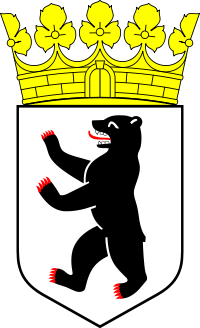- Coat of arms of Berlin
-
Coat of arms of Berlin 
Versions 
State logo in black and white
Coloured state logo
State logo in silverDetails Armiger City of Berlin Crest A city coronet Or with five leaves and a gate Escutcheon Argent a bear rampant Sable langued and armed Gules Use The state logo may be used by the general public while the coat of arms proper is only eligible for use with authorities. The coat of arms of Berlin is used by the German city state as well as the city itself, while Berlin's various boroughs use their own emblems. The bear was not the original symbol of the city, but instead had to 'struggle' to establish its place as such. For many centuries, the bear shared the spotlight with the eagles of Brandenburg and Prussia on Berlin's coats of arms and seals.
Contents
State Coats of Arms
After the formation of the constitution of Berlin, the bear became the animal of coats of arms and seals. The state coat of arms depicted, in a silver (white) shield, a red armed and red tongued, upright, grunting bear.
History
When more and more cities were being founded in the 12th and 13th centuries, cities wanted official seals and later their personal coat of arms to seal official documents such as covenants or orders. A seal or coat of arms was usually awarded by the sovereign. Berlin and Cölln (not to be confused with Cologne) as well as the surrounding cities of the Margraviate of Brandenburg were governed by the Brandenburg Margraves, whose symbol was the red eagle. The oldest preserved and known seal of Berlin is from 1253. It depicts the Brandenburg Eagle spreading its wings in a clover-shaped archway. The text on the seal is SIGILLVM DE BERLIN BVRGENSIVM (seal of Berlin's citizens). It supposedly was the seal of Berlin's first mayor Marsilius.
The usual coat of arms, in use in different styles until the year 1920, showed the Prussian eagle in the first field, the eagle of Brandenburg in the second field and the bear in the third field.[1]
Berlin’s citizens, however, wanted their own symbol and coat of arms. How or why they chose the bear remains unknown. Most likely they were thinking of Albrecht I, nicknamed "the bear", who is considered to have been the conqueror and founder of the Margraviate of Brandenburg. Another possibility is that Berliners decided on "speaking" arms since the first syllable of Berlin sounds like "Bär" (bear), although the two are not etymologically related. In medieval times "speaking" or canting arms were a favorite; people tried to depict names by use of phonetically similar symbols or rebuses. The name "Berlin" was created when slavic tribes settled in the area and means "place at the swamp" or "in a swampy area".[citation needed] Actually, a pearl may have been a more likely choice for canting arms given that the Middle High German word for pearl is "berle".[citation needed] Middle High German was the language spoken at the time and, indeed, pearls were often used in coats of arms.[citation needed]
State logo
To enable civilians and non-governmental institutions to express their affinity with Berlin, the Senate of the Interior and Sports provided a logo which features the arms' shield without the crown in black and white or coloured versions.
Legal status
The coat of arms was laid down in a law of 1954:
§ 1 (1) The coat of arms shows on a silver (white) shield, a black bear rampant with tongue and claws in red. On the shield rests a golden five leaved crest coronet, whose tiara of brickwork is provided with a gate in the center. ... § 4 Decisive for the design of the state’s coat of arms, the state’s flag... are the patterns, added to this law. According to the state’s coat of arms, an artistic design is reserved to special purposes.
—Federal Government, Law on the State Symbols of the State of Berlin of 13 May 1954 (GVBl. S. 289) [2]See also
- Flag of Berlin
- Origin of the coats of arms of German federal states
References
- ^ Senatsverwaltung für Inneres und Sport. "Der Bär im Berliner Wappen - ein geschichtlicher Abriss". http://www.berlin.de/sen/inneres/hoheitszeichen/wappengeschichte.html. Retrieved 2007-10-11.
- ^ Gesetz über die Hoheitszeichen des Landes Berlin
- This article incorporates information from the German Wikipedia.
Berlin topics Government Society History · Geography · Culture · Dialect · Demographics · Economy · Education · Transport · People · Sport · ReligionRelated topics Metro Region · Landmarks · Castles · Museums · Places of worship · Venues · Universities · Parks and forests · CemeteriesMain category · Germany portal Categories:- German coats of arms
- Berlin culture
- History of Berlin
Wikimedia Foundation. 2010.


